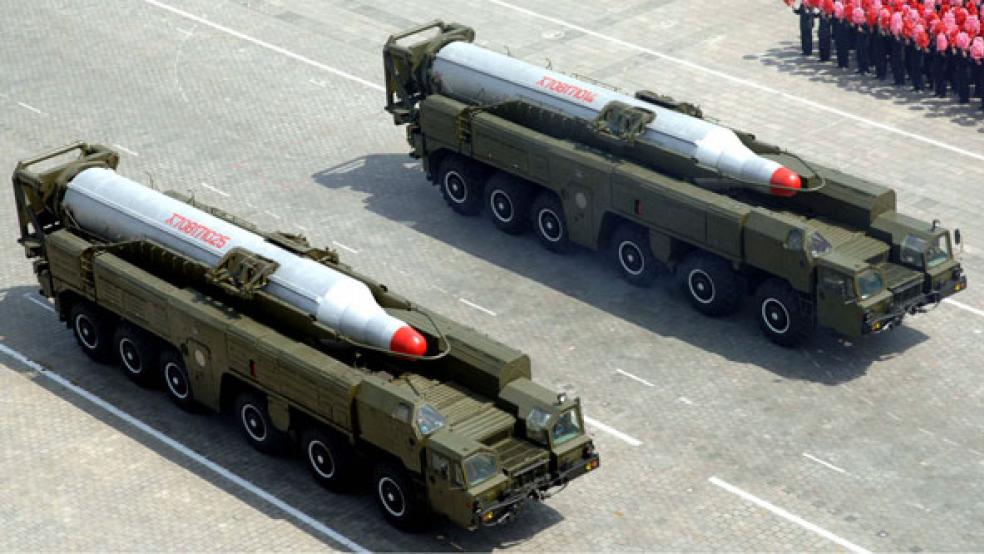It’s not just the unpredictability of U.S. President Donald Trump and North Korean leader Kim Jong-un that make the volatile situation in and around the Korean Peninsula increasingly worrisome.
In the past week or so, there are growing indications that the missile and nuclear capabilities of the gleefully belligerent North Korean regime are moving forward at a faster clip than Western analysts previously predicted.
Related: At the Brink with North Korea: Why This Time It Could Be Serious
Even new South Korean President Moon Jae-in, who favors a dialogue with the North and has called for dialing back the rhetoric on both sides, said on Wednesday that there is a ‘high possibility” of conflict.
Among the reasons why Pyongyang is scarier than it was a month ago are:
Its Missile Technology Is Reaching New Heights. South Korea’s Defense Minister said on Tuesday that a missile fired on Sunday by the North suggests that Pyongyang’s aim of producing a projectile that can carry a nuclear warhead as far as the U.S. is more advanced than previously thought.
John Schilling of the widely-watched website 39 North, which analyses developments in North Korea, wrote on Wednesday: “[The] latest successful missile test represents a level of performance never before seen from a North Korean missile. The missile would have flown some 4,5oo kilometers if launched on a maximum trajectory. It appears to have not only demonstrated an intermediate-range ballistic missile (IRBM) [range] that might enable them to reliably strike the U.S. base at Guam but more importantly, may represent a substantial advance to developing an intercontinental ballistic missile (ICBM).”
The missile launch was detected by new THAAD anti-missile system installed in South Korea, which is equipped radar that Raytheon claims can track a baseball hit out of a park from hundreds of miles away.
Its Nuclear Capabilities May Be Underestimated. In a Q&A on the website of the Bulletin of the Atomic Scientists, Stanford Professor Siegfried Hecker, an expert on plutonium science, said: “North Korea does not yet have the capability to reach the U.S. mainland with a nuclear-tipped missile…although the missile test on Sunday brings it somewhat closer. Its solid-fueled rockets, which are of greatest concern because they can be launched quickly and from hidden locations, have failed regularly. It will need to miniaturize warheads to a much greater extent than it is currently likely capable of doing, and the warheads must survive the stresses at launch and the high temperatures and stresses during re-entry. At the current pace, North Korea may be able to make the technological progress required for a nuclear-tipped ICBM in five or so years.”
Related: North Korea Remains the Most Reviled Country Among Americans in New Poll
Hecker said that the North would likely be able to mount a nuclear warhead on a short-range missile with the range to hit South Korea or Japan. However, the Korean Central News Agency, which is controlled by Pyongyang, said that the Hwasong-12, as the missile fired on Sunday is being called, is “capable of carrying a large-size heavy nuclear warhead.”
While KCNA claims are not given much credence, nuclear expert Mira Rapp-Hooper of the Center for a New American Security, told Alex Ward of Vox that “this new missile suggests that [North Korea’s] programs are advancing quickly” and a nuclear-tipped ICBM capable of reaching the U.S. mainland “may be only a year or so away.”
A Preemptive Strike by the U.S. Would Not Be Totally Effective. Hecker estimates that Pyongyang has enough plutonium and highly enriched uranium to produce 20 to 25 nuclear weapons and said there is “no conceivable way” the U.S. could destroy them all with a preemptive strike. In any case, he said, such a strike would likely “create a mushroom cloud over the Korean Peninsula.”





